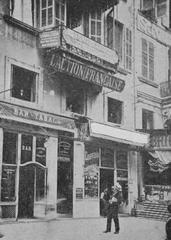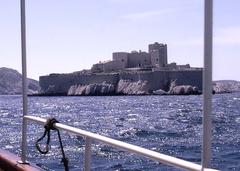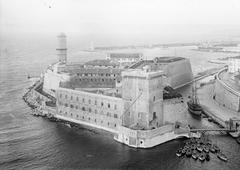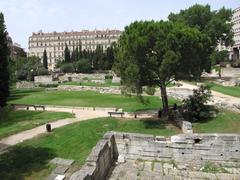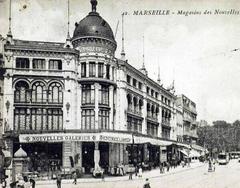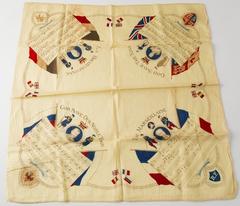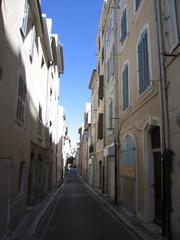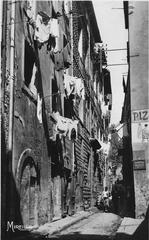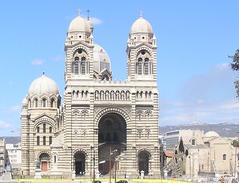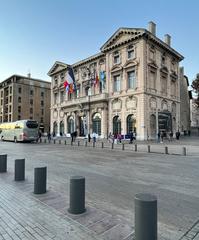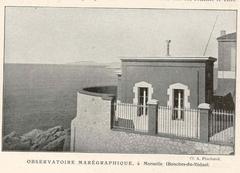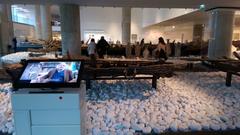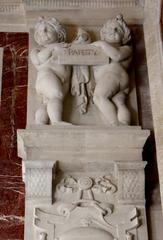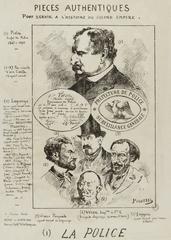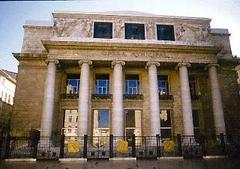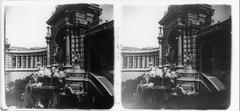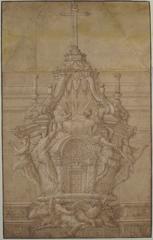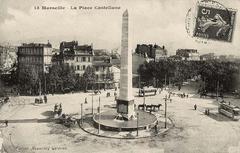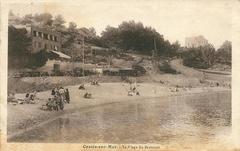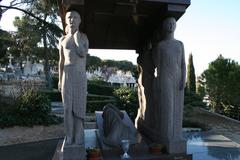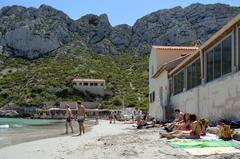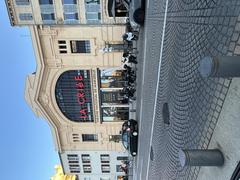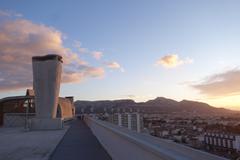
Église Saint-Ferréol Les Augustins Marseille: Visiting Hours, Tickets, and Historical Site Guide
Date: 04/07/2025
Introduction
Situated in the heart of Marseille’s vibrant Vieux-Port, the Église Saint-Ferréol Les Augustins is a living testament to the city’s layered religious, cultural, and architectural history. Built on grounds once owned by the Knights Templar and later entrusted to the Augustinian hermits in the 14th century, the church has evolved through centuries of devotion, artistic patronage, and urban transformation. Today, it remains an active parish and a must-see destination for visitors interested in Marseille’s spiritual and historical heritage (tourisme-marseille.com; spottinghistory.com).
This comprehensive guide explores the church’s origins, key architectural features, significant artworks, and practical visitor information—including up-to-date visiting hours, ticketing, accessibility, and tips for making the most of your visit. Whether you are a history enthusiast, art lover, or spiritual pilgrim, Église Saint-Ferréol Les Augustins offers a unique window into Marseille’s enduring faith and community spirit. For the latest updates or immersive tours, consult official tourism resources and the Audiala app (marseille-tourisme.com).
Table of Contents
- Historical Background and Foundation
- Architectural Evolution
- Artistic Heritage and Interior Highlights
- Religious and Civic Significance
- Visiting Information
- Nearby Attractions
- Frequently Asked Questions (FAQ)
- Conclusion
- References
Historical Background and Foundation
The site of Église Saint-Ferréol Les Augustins has deep medieval roots. Initially, the land belonged to the Knights Templar, a powerful military-religious order, before being transferred to the Augustinian hermits in 1369 after the Templars’ suppression. Supported by Robert I of Naples, Count of Provence, the Augustinians established a new church within the city’s fortified walls, seeking security and a strategic location by the port (tourisme-marseille.com; spottinghistory.com).
Construction began in 1447, progressing slowly—reflecting both the order’s limited resources and their commitment to asceticism. The church was consecrated in 1542, yet the stone vaults were not completed until 1588. Over the centuries, the church’s role expanded from a monastic chapel to a focal point for Marseille’s guilds and a burial site for prominent families (marseilletourisme.fr; saintferreolmarseille.fr).
Architectural Evolution
Medieval and Renaissance Periods
The church’s core structure, including its nave and side chapels, dates to the late 15th and 16th centuries. Built in the Gothic tradition, the thick stone walls and arched vaults reflect the era’s architectural priorities of durability and spiritual grandeur. The original entrance faced a now-vanished narrow street, underlining the church’s integration into the medieval urban fabric.
Urban Transformation and 19th-Century Changes
Marseille’s expansion under Louis XIV in the 17th century shifted the church’s position from the city’s periphery to its center. The French Revolution threatened its existence, but instead of demolition, the church became the seat of a new parish, with parts of the building removed for urban redevelopment. In 1803, after the destruction of the original Saint Ferréol church elsewhere in the city, this church received its present dedication.
The most striking external feature today is the neo-classical façade, constructed in 1874 and clad in 1875 by Joseph Letz. This façade, a result of 19th-century urban renewal, faces the Vieux-Port and gives the building its distinctive appearance (tourisme-marseille.com).
Unique Architectural Features
A rare aspect of the church is the presence of merchant shops incorporated into its exterior façades—an unusual blend of sacred and commercial spaces, highlighting the deep integration of the church into Marseille’s portside daily life (tourisme-marseille.com).
Artistic Heritage and Interior Highlights
The church is home to an impressive collection of artworks spanning several centuries:
- High Altar: Crafted by Dominique Fossati in polychrome marble, the altar is a Baroque masterpiece and focal point of the sanctuary.
- Paintings by Michel Serre (1658–1733): Notably Sainte Marguerite, La Vierge à l’enfant apparaissant à Saint Pierre, and Saint Paul.
- Sculptures: Includes works by Raymond Servian (Saint Ferréol de Vienne, Saint Augustine), Élie-Jean Vézien (Saint Theresa), Louis Botinelly (Joan of Arc), and a modern Holy Family by Yves le Pape (1979).
- Historic Pulpit: An 18th-century carved wooden pulpit, classified as a historic monument, notable for its Rococo reliefs and craftsmanship.
- Stained Glass Windows: Filter Mediterranean sunlight into the nave, depicting biblical scenes and saints.
- Neogothic Pipe Organ: Built by Augustin Zieger in 1844, it is featured in regular concerts.
- Family Tombs and Relics: The Mazenod and Montolieu family tombs and relics of Saint Louis of Toulouse (though stolen in 1993) reflect the church’s spiritual and social significance (Wikipedia; mikestravelguide.com; nomads-travel-guide.com).
Religious and Civic Significance
Église Saint-Ferréol Les Augustins has played a central role in Marseille’s spiritual and civic life:
- Guild Chapels: Various trades, including bakers, blacksmiths, porters, and rope-makers, maintained chapels and held patronal ceremonies within the church.
- Burial Site: Numerous vaults beneath the nave and in the chapels were used by noble and prominent families.
- Historical Events: Hosted the wedding of Catherine de’ Medici and Henry II of France in 1533, officiated by Pope Clement VII.
- Modern Parish Life: Today, the church remains active, entrusted to the Jesuit order, hosting regular Masses, confessions, and spiritual events open to all (saintferreolmarseille.fr).
Visiting Information
Visiting Hours
Église Saint-Ferréol Les Augustins is generally open:
- Monday to Saturday: 09:00 – 18:00
- Sunday: 15:00 – 18:00
Hours may vary on holidays or during special events. Always check the official parish website or Marseille tourism site for the latest updates.
Admission and Tickets
- Entry: Free of charge for all visitors.
- Donations: Welcome and support the church’s preservation and cultural activities.
- Special Events: Concerts or special ceremonies may require advance booking or tickets—see notices on site or online.
Accessibility
- Main entrance: Wheelchair accessible.
- Facilities: Ramps and accessible restrooms available.
- Interior: Some areas may have uneven flooring due to the church’s age; assistance is available upon request.
Guided Tours
- Self-Guided: Visitors can explore at their own pace; information panels and brochures are available.
- Guided Tours: Offered occasionally through the parish or local tourism offices. Booking in advance is recommended, especially during high season.
Getting There
- Location: Quai des Belges, 1st arrondissement, Marseille, directly on the Vieux-Port (Wikipedia).
- Metro: Line 1, Vieux-Port station.
- Bus: Lines 49, 83.
- Walking: 5-minute walk from Old Port.
- Accessibility: Central location, easily reached by foot, bike, or public transport.
Visitor Tips
- Dress modestly as a sign of respect.
- Photography is permitted, but avoid flash and respect worshippers.
- Visit in the morning or late afternoon for a quieter atmosphere and the best natural light on the stained glass.
- Check for concerts or organ recitals to experience the church’s renowned acoustics.
Nearby Attractions
Combine your visit to Église Saint-Ferréol Les Augustins with other notable Marseille sites:
- Le Panier: Historic old town with artisan shops and cafés.
- Basilique Notre-Dame de la Garde: Iconic hilltop church with panoramic city views.
- Musée d’Histoire de Marseille: Learn more about the city’s past.
- Abbaye Saint-Victor and Cathédrale de la Major: Other significant religious landmarks.
(nomads-travel-guide.com; mikestravelguide.com)
Frequently Asked Questions (FAQ)
Is there an admission fee?
No, entry to the church is free; donations are appreciated.
What are the visiting hours?
Generally, Monday–Saturday 09:00–18:00, Sunday 15:00–18:00. Check the official site for updates.
Is the church accessible for wheelchair users?
Yes, the main entrance is accessible and assistance is available.
Are guided tours available?
Guided tours can be arranged through the parish or local tourism offices; book in advance.
Can I take photographs inside?
Yes, but please avoid flash and respect worshippers.
Are special events or concerts held in the church?
Yes, especially organ recitals. Event schedules are posted on the church’s website and notice boards.
Conclusion
Église Saint-Ferréol Les Augustins is more than a historic monument—it is a vibrant cultural, spiritual, and artistic landmark at the heart of Marseille. With its blend of medieval origins, Baroque artistry, and 19th-century renewal, the church offers an enriching experience for all visitors. Free admission, central location, and accessible facilities make it an essential stop on any Marseille itinerary.
For the most current information on visiting hours, events, and guided tours, consult the official parish website or the Marseille tourism site. Download the Audiala app to enhance your exploration with self-guided audio tours and exclusive content.
References
- tourisme-marseille.com
- marseilletourisme.fr
- saintferreolmarseille.fr
- Wikipedia
- marseilleavantapres.fr
- mikestravelguide.com
- nomads-travel-guide.com
- spottinghistory.com




